Don't wanna be here? Send us removal request.
Text
The Cost of Being A Skilled Professional
Sitting with my grandmother listening to her stories I often hear her mention how she never used to need a license to drive, she never had a cell phone and she didn't need to graduate from high-school to get a good job. When she mentions her education and the levels present in her era I often find myself comparing current times to hers. As it stands now you have very limited options for work if you don’t have a high school diploma, and even more so you're required to have some sort of post secondary education to get a well paying job you can sustain off of. When I graduated high school I knew that I wanted to go to college, but the cost of it scared me. I had never had large amounts of debt before so the idea of going thousands of dollars in debt for education wasn't my ideal plan. I ended up settling for a shorter course that would get me a job but wouldn't put me too far under. However the economy wasn't so kind and the availability of jobs I had trained for was very limited for a fresh 20 year old with no previous experience. I realized then that I needed to go back to school to get a more secure job. When I first started browsing new careers I was horrified, not because I would be stuck going to school for a few years, but because I would be selling my soul to Canada/Alberta student loans for years to come.
I almost didn’t take the jump into the Bachelor of Science Nursing program at Red Deer College because I simply could not afford the schooling, but with student loans and a part time job I am some how making it work. Money, it controls everything. So the question popped into my head, if we are requiring that so many people have a higher education, why are we making it so expensive? I am fortunate enough to qualify for student loans but I know there are many who do not and post secondary education is simply not an option. In this generation we are requiring that our citizens have a increased education and yet we are making it so expensive we are losing out on many people who would like to obtain a higher education and thus would increase the amount of skilled professionals we have.

In the past decade tuition costs has increased 40% (Cain, 2016). Stats Canada also released information that stated “ Canadian full-time students in undergraduate programs paid, on average, $6,373 in tuition fees for the 2016/2017 academic year, 2.8% higher than the 2015/2016 average ($6,201)” (Government of Canada , 2016). It is shown that education costs has increased each year in the past decade, making it even less of an option for those already struggling. Follow the link to see the increase of education costs since the 2013 release.
http://www5.statcan.gc.ca/cansim/a26?lang=eng&retrLang=eng&id=4770122&&pattern=&stByVal=1&p1=1&p2=31&tabMode=dataTable&csid=
In order for Canada to continue progression we need our citizens to have better access to education so we can have a steady influx of trained professionals. If we continue increasing the cost of education we may reach a crisis point where we do not have enough trained individuals to meet the demands of society. An article published in 2015 discusses how tuition costs may affect a students decision to go to school or not, and as a personal experience I understand this entirely. (Atherton, 2015). However, studies have been done that contradict this directly stating that tuition costs do not affect a students decisions to attend college (Rivard, 2009). Although the statistics are there it is my personal belief that tuition costs does deter people from attending school, maybe not forever but at least for some time. I am a prime example, situation forced me back to getting a better education and the only way to get it was to acquire more debt in student loans.
When I consider my grandmothers stories about her time, the education required isn't the only difference. The cost of living is much higher now than it was back then, requiring society to constantly be pushing and straining to stay afloat. The cost of education is not the only problem Canadians can have, but it is one we could do something about. The video below is a proposal for the way free tuition could be achieved in the states, if Canada could do something similar we could make it easier for Canadians to progress. Now some limitations to the video below do exist in that it is a US video, and the economy and logistics are different in each country. However, the same idea could lead us to a tuition free country, find the allocated resources and pool them into education.
youtube
Free tuition may not be the solution to maintaining a steady stream of skilled professionals with a quality education. Some could argue that with free education there is the potential for abuse of that system which is understandable, but the work required to get those degrees is still the same. I believe the key to advancement is free tuition, making education more accessible to those who otherwise wouldn't be able to go or would drown in student loans as I am. I will come out of my program a trained and skilled professional, but I will also be over $85,000 in debt.
Atherton, G. (2015, May 01). Higher tuition fees are distorting the choices poorer students make. Retrieved February 25, 2018, from https://www.theguardian.com/higher-education-network/2015/may/01/higher-tuition-fees-are-distorting-the-choices-poorer-students-make-lower-tuition-fees-could-see-poorer-students-applying-for-different-courses
Cain, P. (2016, September 07). University tuition fees in Canada rise 40 per cent in a decade. Retrieved February 25, 2018, from https://globalnews.ca/news/2924898/university-tuition-fees-rise-40-per-cent-in-a-decade/
Government of Canada. (2016, September 07). Tuition fees for degree programs, 2016/2017. Retrieved February 25, 2018, from http://www.statcan.gc.ca/daily-quotidien/160907/dq160907a-eng.htm
Photography, K. (2015, February 08). Stock Photography - Canadian Money. Retrieved February 25, 2018, from https://www.flickr.com/photos/morbokat/15853636044
0 notes
Text
Gender Inequality- Its Still a Problem
As a young girl I had never considered that being a female would lay out the way I was supposed to live my life. It had never occurred to me. My parents never bound me to a role based on my gender, if I wanted to wear blue I got to wear blue. If i wanted to go play in the mud, they joined me. If I wanted to build birdhouses instead of play with dolls I was allowed and provided the materials. It wasn't until I was older did I realize these were things that little girls “weren't supposed to do”. Girls were supposed to play with dolls and wear pink, have play kitchens and not be interested in playing in the mud. Fast forward to my junior high years. I appalled my home ec teacher when I opted to sign up for the shop/construction class instead of the cake decorating class. My gym teacher was thrown for a loop when I , a girl, asked if we could play football. There were many little things among my high school years that showed a large gap between genders that I took as harmless. My eyes weren’t opened to the massive inequities between the genders and the perceived roles we should be playing until I was speaking to my peers about what they wanted in a spouse. A common theme emerged from the men, they wanted a cute little wife who would take care of the children, clean the house and do the laundry. They wanted a nice home cooked meal when they got home and a girl that “took care of herself”.” Well what about her career?” I asked, “oh, my wife wont work”. I could not wrap my mind around this concept. All of these little stories and comments bring me to one statement. Sexism is still a problem.
In my own opinion, gender inequalities are often seen by women more because we are subject to the gender discrimination more. For example- catcalling. This is street harassment, and women are most often the target. The video below shows a young woman modestly dressed, she does not engage with anyone she simply walks.
youtube
In ten hours the women gets more than 100 comments or approaches in ten hours.A video was released in response to this; men were asked why they catcall. Watch to 1:38 min
youtube
According to these men; It is the woman's fault she is being catcalled because of what she chose to wear. It is a mans right to comment on a woman's body, whistle or pucker at her. Men do it to appear macho in front of their friends. I don’t know about you but I see some serious flaws in this. Lets talk about the mans statement that it is his right to say as he pleases, its freedom of speech. No good sir, that is not how this works. The Canadian Human Rights Charter does say that “ The freedoms of thought, belief, opinion and expression are protected as a fundamental constitutional guarantee in section 2(b) of the Charter.: However, the Charter has limitations and restrictions on freedom of speech such as any “offences against the public order, offences related to falsehood, offences against the person and reputation, offences against the administration of law and justice, and offences related to public morals and disorderly conduct.” are not allowed. The right to be free of discrimination based on gender directly contradicts this mans right to freedom of speech.
Now this is not to say that men don’t get catcalled, they do as well but the majority of cases are women. The graph below represents the 2014 national street harassment report. (Stop Street Harassment, 2014)
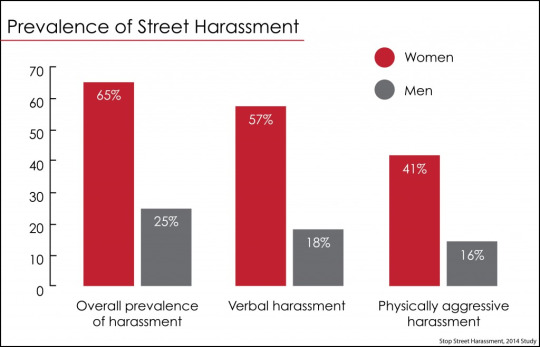
This is a significant problem or women, one that is deemed “not a big deal”. I have personally been catcalled many times and in my experience I become fearful for my safety in those situations. I asked some of my male friends how they would feel if women catcalled them, and they laughed and joked. In the video when asked if they would like it if it was their sister or mother being catcalled the men’s position on catcalling changed immediately. Its a serious topic if it involves a female you love, but the others? Na. This is just one example of the way society is still sexist towards women. Why is it acceptable to speak to women this way?
Another example of day to day sexism is the dress codes in high schools. Have you read any recently? I have, they are almost exclusively catered to girls clothing. In some cases they schools have even blamed the girls clothing as the reason the boys are distracted and if they would cover up the boys learning environment wouldn't be impacted. As if a woman's clothing is more important that her education.
Read the article : https://www.parent.com/school-assembly-blames-girls-for-distracting-boys-from-learning/
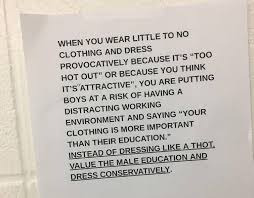

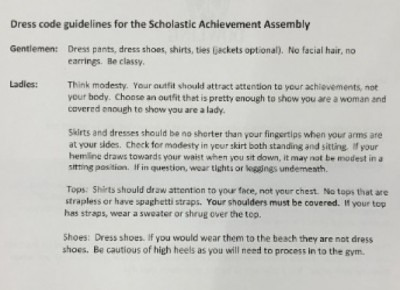
Though blurry you can see that the men have a few lines, and women have half a page. The uproar about the dress codes being sexist isn't a new idea, and women have banned together in a public outcry.
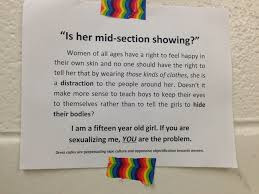
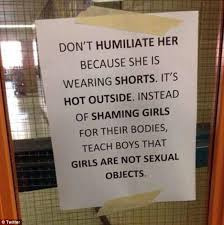

Dress codes and catcalling are just two areas that women are subject to discrimination based on their gender. I have never heard of a female claiming she was distracted from her education by a mans shoulders or legs. The gap between genders is still very real and very large. Women want equality, we want to be treated as equals in the world. Not these beings that are sexualized objects meant to cook, clean, wear pink and do girly things. We are not asking to be above men or to be treated better than them, we just want and equal playing field. This is not to say men never get dress coded or never experience cat calling, they absolutely do. Just not at the same rate as women and not for the same reasons. A women is no less professional because of the hem or her skirt. She is no less capable of being a welder, rig hand or farmer due to her gender. She is allowed to have the high power career or better paying job, she does not have to cook and clean and dote on a man. We ask for equality, I can cook, but you should cook sometimes too. You don’t have to be the only source of income, I can work too. The sooner we level the playing field and have true gender equality, the sooner we can focus on other important issues globally. Me being a women and you being a man is not the only problem this world has and seems ridiculous when people are starving or wars are being fought. I was not made to stand behind you, I was not made to stand in front of you, I was made to stand beside you so that we may face the world together.
Current Publications: Law, justice and rights. Parliament of Canada (n.d.). Retrieved February 14, 2018, from https://lop.parl.ca/Content/LOP/ResearchPublications/2010-31-e.htm
Spencer, A. (2016, May 05). School Assembly Blames Girls for Distracting Boys From Learning. Retrieved February 14, 2018, from https://www.parent.com/school-assembly-blames-girls-for-distracting-boys-from-learning/
Statistics - Stop Street Harassment Studies. (n.d.). Retrieved February 14, 2018, from http://www.stopstreetharassment.org/resources/statistics/sshstudies/
Urbanski, D. (2015, March 13). HS School President Defends Sexist Dress Code: Girls Attire Stricter Because There Are More Styles and Options Available for Them. Retrieved February 14, 2018, from https://www.theblaze.com/news/2015/03/13/hs-school-president-defends-sexist-dress-code-girls-attire-stricter-because-there-are-more-styles-and-options-available-for-them
0 notes
Text
Eradication- Is it possible?
The wind is chilled, the snow is falling and the noses are sniffling. Classmates begin dropping like flies, hoarse voices strain to speak and it seems to be a never ending distribution of Kleenex and hand sanitizer. It is the dreaded flu season. “Have you gotten your flu shot yet?” everyone will ask. More often then not people will tell you yes they have or they've been meaning too, but its increasingly common that people will tell you no, vaccines are bad for you.
If you search up vaccine side effects you are bombarded with a list of search results that have contradictory statements. Some are in support of vaccination, but many are not. For example the website www.stopmandatoryvaccinations.com lists an incredibly large amount of side effects all severe or fatal from getting a vaccination. To the untrained eye these websites are factual and have enough evidence to scare anyone away from getting immunized. Did you know vaccines cause autism? Two seconds on google and I believe it too. To health care providers this is a question we all hate to hear. Andrew Wakefield is the man responsible for this misconception. He conducted a study on the MMR vaccine for measles mumps and rubella concluding that the MMR vaccine caused autism. His study was published to the world and panic set in , causing people to flee away from the pharmacies and skip their vaccinations. If that vaccine caused autism, what do the other vaccines cause? Twelve years after the paper was published, Andrew Wakefields study was retracted and he was struck from the registrar of medical professionals. It was found that he had falsified information and findings and that there was no correlation between autism and the MMR vaccine. However his message that vaccines are bad for you stayed strong for many years and the influence is still felt today.
Andrew Wakefield is one of the reasons eradication of the flu is not possible. Yes, we battle the ever changing and mutating viruses and this too will be a reason we will never be rid of the flu. “Anti-Vaccers” are groups of people who are strongly opposed to vaccinations and often actively protest their use. This had lead to a decrease in herd immunity and the spreading of the flu has increased. Alberta Flu Watch charts and tracks flu activity every week publishing it for Canadians to see. For comparison the first map is Canada in the first week of January in 2012, the second one being January 2018. Notice anything?
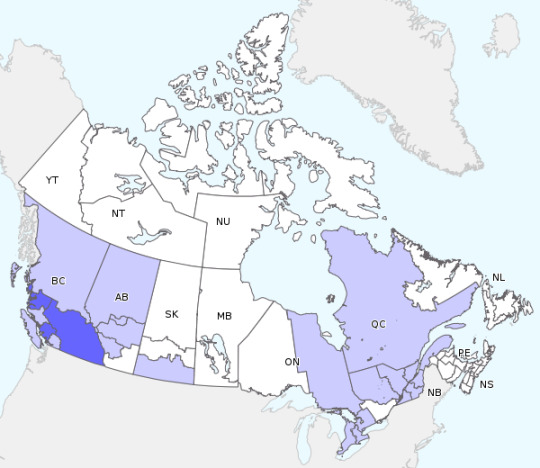
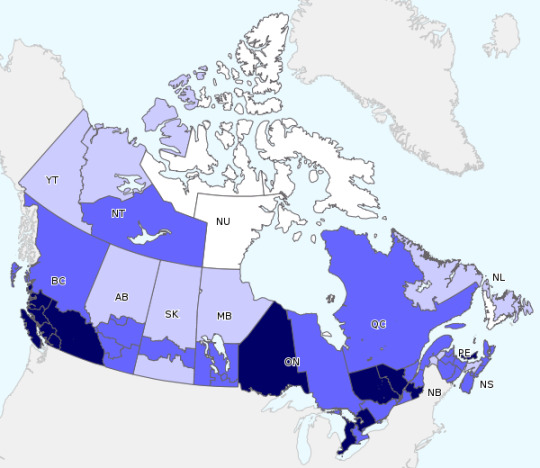
The amount of flu activity is significantly greater in 2018 than it is 2012. We are seeing trends in Canada that are rather alarming. Diseases we have not seen in areas for many years are making a comeback, and its because people are no longer vaccinating against them. The common belief is that since there has not been confirmed cases in Alberta or Canada for some time, the disease must be gone right? This is incorrect, herd immunity is what protects us all. When we continue getting vaccinated we are protecting not only ourselves but the others around us. There are people who due to allergies or medications or even medical conditions can not get the vaccine themselves. They rely on the rest of the public to maintain herd immunity for them.
In order to increase vaccinations we have to kill a belief, one widely accepted by so many. Hundreds and thousands of people are battling to get rid of mandatory vaccinations while the other half are battling to keep them. A belief is a powerful thing, you cannot hold it therefore you can not kill it. We can not study it under a microscope so we can no show you it. All we can do as health professionals is to provide the information for the people and spread the message using evidenced based practice.
https://www.medscape.com/viewarticle/822981
In this video Dr.Caplan explains how we can calm the worries of some clients and hopefully give them the ability to make an informed decision about their children's and their own health.
Nursing students are taught throughout their program to ensure the validity and credibility of a study or a website before we use the information. The general public however is not and may not know what is credible and what is not. We can not control the mutation of a virus but we can control the efforts we use to battle it. Eradication is not possible right now with so many people still hung up on the idea that vaccines are bad for you. Now from their point of view I completely understand their hesitancy. If you don’t understand how a vaccination works or the side effects of it you would rather air on the side of caution. If i were a mother would I allow a doctor to give my child a questionable substance I am not familiar with? Probably not. To be fair to them as well, there are many side effects that can occur with a vaccine which can be alarming. The health care system lost the trust of many over the topics of vaccinations. In a perfect world the solution would be for everyone to do their research, talk to their medical professionals and understand the point of vaccination and the benefits and risks. All we can do is provide our clients with the evidence based research and allow them to make an informed decision about their own health.
Rao, T. S. S., & Andrade, C. (2011). The MMR vaccine and autism: Sensation, refutation, retraction, and fraud. Indian Journal of Psychiatry, 53(2), 95–96. http://doi.org/10.4103/0019-5545.82529
Government of Canada, Public Health Agency of Canada. (2016, February 24). FluWatch maps. Retrieved February 08, 2018, from http://diseases.canada.ca/flu-maps/?FluWeek=wk201801&province=wb&Submit=View%2Bmap#
0 notes
Text
Alberta's Black Abyss
In Canada, each province is known for its role in the country. Some are for their wheat and salt, some are for their seafood, and Alberta too has its own role. Alberta is known as Canada's “Oil Town”. It is home to the majority of the oil sands in Canada, the oil sands underlying 21% of Alberta. The oil sands have many environmental impacts including the tailing ponds impacts, reclamation impacts, climate impacts and water quality, but for the purpose of this blog I want to concentrate on the air/water quality impacts and the consequences that will follow if we do not address the issue of pollution.
The tar sands is one of the largest sources of secondary organic aerosols- air pollutants that affects the formation of clouds, public health and the environment. Alberta's tar sands emit between 55 and 101 metric tonnes of secondary organic aerosols each day. (Magill., 2016) A few of the different particulates released from the tar sands includes sulfur dioxide, nitrogen dioxide,hydrogen sulfide and mercury. Respiratory illnesses such as asthma, COPD and lung cancer are greatly increased by the presence of sulfur dioxide and nitrogen dioxide. Not only can it directly affect humans respiratory health, it also contributes to the formation of acid rain. Acid rains are created when the sulfur/nitrogen oxides are released into the atmosphere when fossil fuels are burned. The presence of it in the air means it can travel great distances affecting the acidity of soil and water bodies making it unsuitable for consumption. This largely impacts the wildlife and availability of fresh water. Not only does it affect the acidity it also creates the presence of algae blooms that are dependent and thrive on nitrogen, killing fish and the other plant life in the water. (Dyer., 2009)

The population the world has right now is not able to sustain itself, the impacts air pollution has on the water and soil is only going to further decrease our ability to produce food and have available fresh water. The effects of air pollution is more than just hazy air and increased respiratory illnesses. It will continue to negatively effect our ability to produce food and maintain a fresh water supply. Fresh water is used to extract the bitumen and usable substances from the tar sands. It is horrendous that we are using and damaging so much fresh water when we have the science and ability to figure out ways to limit the pollution levels we see. In the video below , residents discuss the issues they have noticed with the Athabasca River since the industrialization. The river passes by the oils sands and studies have shown that the amount of harmful particulates in the water increases drastically after the oil sands.
New progress is being made for the recycling of water for use in the oil sands to limit the use of fresh water, but more needs to be done. The levels air and water pollution we allow needs to be revised and oil companies must find a way to decrease it. It is estimated that only 2.5 % of the earths water is fresh, and even then most of that is trapped in glaciers leaving even less for us to use. The careless way we use fresh water is going to result in a fresh water crisis. The amount of fresh water hasn't changed, but the amount of people on this planet has. “By 2025, an estimated 1.8 billion people will live in areas plagued by water scarcity, with two-thirds of the world's population living in water-stressed regions as a result of use, growth, and climate change”.(Hodgson., 2017) This is our planet, the only one we have and we are ravaging it. Our own selfishness and greed for money or luxury is beating our empire to dust. What was such a natural and beautiful world has been poisoned. We need to reevaluate how we are treating our world so that we can ensure the survival of it and our descendants. Wrecking our planet is not justifiable for pieces of green paper with dollar signs on it.
Dyer, S. (2009, September 21). Environmental Impacts of Oil Sands Development in Alberta. Retrieved January 28, 2018, from http://www.resilience.org/stories/2009-09-22/environmental-impacts-oil-sands-development-alberta
Free Images : sea, coast, water, ocean, river, rapid, geological phenomenon, wind wave 3596x2393. (n.d.). Retrieved January 29, 2018, from https://pxhere.com/en/photo/119947
Hodgson, J. (2017, January 27). Competing for Clean Water Has Led to a Crisis. Retrieved January 29, 2018, from https://www.nationalgeographic.com/environment/freshwater/freshwater-crisis/
Magill, B. (2016, May 25). New Tars Sands Impact on Air Pollution Found. Retrieved January 28, 2018, from https://www.scientificamerican.com/article/new-tars-sands-impact-on-air-pollution-found/
youtube
0 notes
Text
Poverty- Canada Experiences it Too
Sitting at the table during family dinners politics and poverty are bound to come up, and my family is no exception. Many areas of conversation are covered and often are surrounded by comments on poor starving children in Africa, or those poor children on the world vision commercials with flies in their eyes and skeletal build. I feel the deepest of sympathy for these people, but then it occurred to me that people rarely discuss poverty in Canada. Does it exist? Where and why? Is this even a problem in Canada. Of course it is! A recent article posted by global news stated that there are 1.2 million Canadian children living in poverty as evidenced by the Canadian statistics census. (Young., 2017) What was interesting was that in these statistics it was apparent that households that have more children are more likely to be low income and living in poverty. The article offers some explanations for this including the loss of wages during the first year of a child's wife, single income or single parent situations etc.
All the information prior only includes the children, if we consider the other Canadians in poverty the number increases to 4.9 million. This includes those with disabilities, the elderly and the homeless. If we have so many people in poverty in Canada why are we not doing anything about it ? How can we be expected to help other countries in poverty when we cant even eliminate poverty in our own home? The government does not currently have a plan to fix poverty in Canada, they only have a “management” plan. A recent article stated it cost Canadians 70 billion dollars to manage poverty. (Keith., 2017) Why could we not use 70 billions dollars to implement a plan to eradicate poverty instead of managing it? I firmly believe that Canada can not efficiently help poverty world wide until we are able to sustain our own people.
One issue that is near and dear to my heart as a student us the lack of education. This is a factor greatly impacting impoverished Canadians. In order to increase ones earnings education is required to practice at a higher level. The problem is many Canadians can not afford to get an education. Yes , there are student loans, but the looming debt after completing a program often turns people away from bettering themselves with more education. Or if they do go ahead and get an education the left over debt from school follows them for years to come. How can we expect to get ahead when either way we are required to increase our debt. As a personal example, I have previously taken a college course at SAIT, the course and year living cost me about $20,000 total. Once I completed the course I had to pay for an exam about $1000 and had to go to Edmonton to write it, once I passed again I had to pay a registration fee of $600 and this is a yearly fee. Fast forward a few years and job availability left me searching for a new career that I could support myself on. As a current nursing student each year of school with living expenses will cost approximately 15-20,000 dollars. Multiply that by four, add the previous debt. You have an astounding $80-100,000 that I will have to spend on my education. When I graduate I will have a large amount of debt following me and then will still have to try and feed myself, have a roof over my head, pay insurance and bills. The cost of education is suffocating Canadians. Educating the country can help eliminate poverty, “ By educating an entire population, economic growth is a natural effect. Studies show that each extra year of schooling can increase a person’s salary by 10 percent later in life. This means that a country’s GDP can increase by 1 percent annually by providing education to its entire population. Increasing a country’s GDP creates innumerable opportunities for trade and development.” (Cleaveland., 2014)
As mentioned before , Canada spends billions of dollars on managing poverty. However, I believe a start to eliminating poverty would be to make education more affordable. Use the money that is “managing” poverty and put it into programs that can offer cheap or even free education. The more education the public has the better of a chance they have to be a self sustaining individual with more opportunities for work. There are many reasons why poverty occurs, but we must start by addressing key issues that factor into it. Canada does not have to have the rates of poverty that we do there are many options and solutions. The first step is to recognize that we too have poverty, it is not just a “poor country’s” problem.
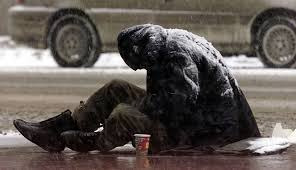
.
Cleaveland, H. (201, June 22). Outsmarting Poverty: Projects Improving Education in the Philippines. Retrieved January 22, 2018, from https://10ztalk.com/2018/01/22/outsmarting-poverty-projects-improving-education-in-the-philippines/
Just the Facts. (n.d.). Retrieved January 22, 2018, from http://www.cwp-csp.ca/poverty/just-the-facts/
P. (2017, August 18). Poverty in Canada is a Canadian Problem. Retrieved January 22, 2018, from https://cpj.ca/poverty-canada-canadian-problem
Young, L. (2017, September 13). 1.2 million Canadian children living in poverty: census. Retrieved January 22, 2018, from https://globalnews.ca/news/3739960/canadian-census-children-poverty/
0 notes